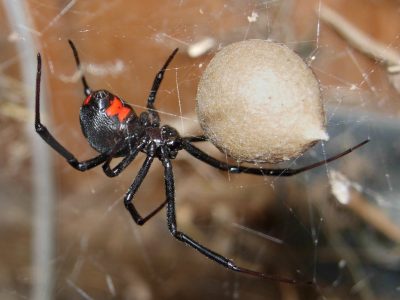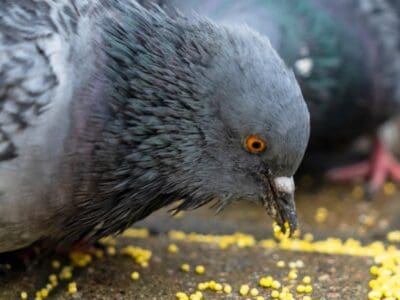Escolar
Lepidocybium flavobrunneum
Its system can’t metabolize wax esters, which can lead to unpleasantness for diners.
Advertisement
Escolar Scientific Classification
- Kingdom
- Animalia
- Phylum
- Chordata
- Class
- Actinopterygii
- Order
- Scombriformes
- Family
- Gempylidae
- Genus
- Lepidocybium
- Scientific Name
- Lepidocybium flavobrunneum
Read our Complete Guide to Classification of Animals.
Escolar Conservation Status
Escolar Facts
- Prey
- Other fish, squid, cuttlefish, crustaceans
- Group Behavior
- Solitary
- Fun Fact
- Its system can’t metabolize wax esters, which can lead to unpleasantness for diners.
- Estimated Population Size
- unknown
- Biggest Threat
- Being caught as by-catch by tuna fisheries
- Most Distinctive Feature
- Sideways keel on the tail
- Other Name(s)
- White tuna, butterfish, ex-lax fish, skolier, black oilfish, tuna minyak, snake mackerel, waloo
- Optimum pH Level
- 6.0-8.0
- Habitat
- Temperate and tropical oceans save the northern Indian Ocean
- Predators
- Humans, yellowfin tuna
- Diet
- Carnivore
- Type
- Fish
- Common Name
- Escolar
- Number Of Species
- 1
View all of the Escolar images!
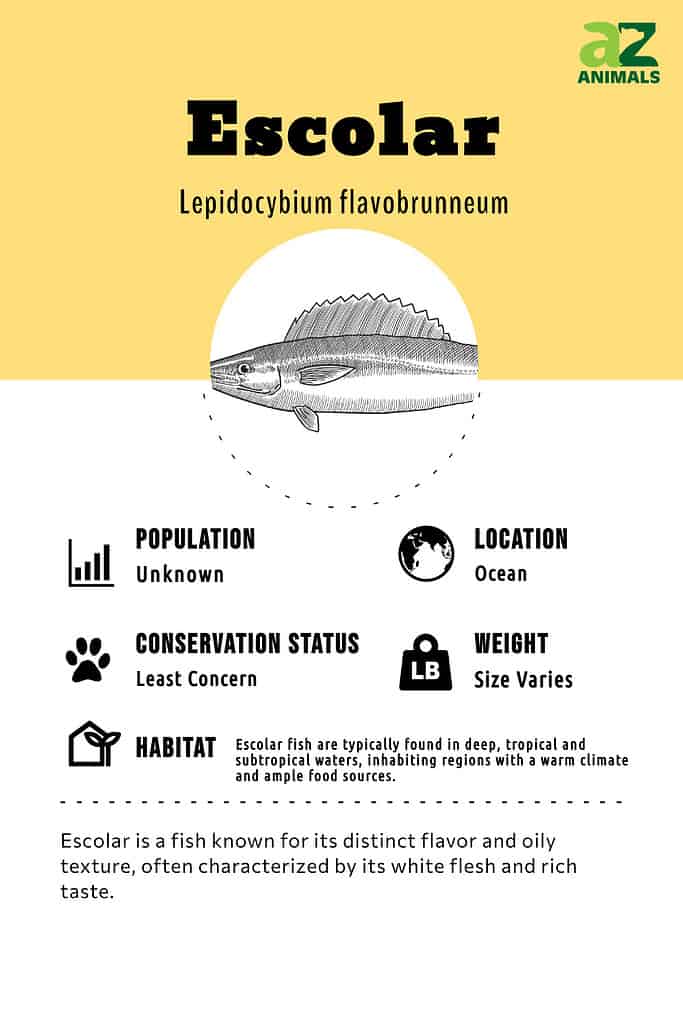
Escolar Summary
“The Bane of Sushi Lovers”
The escolar is one of the best-tasting fish around, and its nutritional values are high. However, if you eat too much of it you might pay with cramping diarrhea! Though you should only eat a little of this fish at a time, it is often mislabeled as something else, and that can lead to problems. But it’s not the fish’s fault. Read on for more info on the escolar.
Five Amazing Facts About the Escolar

Despite being a popular ingredient in nigiri sushi, sushi rolls, and sashimi, escolar is ironically prohibited in Japan due to its adverse health effects.
- Ironically, though escolar is used in nigiri sushi, sushi rolls, and sashimi, it is banned in Japan because of its health effects.
- It is often sold erroneously as “white tuna.”
- Though some people suffer diarrhea if they eat too much escolar, others experience a distressing seepage of orange oil.
- The fish has rings around its eyes that look like eyeglasses, so its common name is Spanish for “scholar.”
- The fish stores the waxy esters it can’t digest in its body, and as much as 20 percent of its weight can be made up of these compounds.
Evolution and Origins
The term “escolar” originates from Spanish, as the rings around the eyes of the fish bear a resemblance to the spectacles worn by scholars, hence its association with the word “scholar.” It is also related to the term “doublet” of scholars.
The escolar is commonly encountered in deep tropical and temperate waters worldwide, with depths ranging from 200 to 885 meters, and it is frequently caught in the coastal waters of Australia and New Zealand.
It is valued as a food source in various European, Asian, and American countries, similar to its relative, the oilfish.
Classification and Scientific Name
The scientific name of the escolar is Lepidocybium flavobrunneum. The genus name comes from the Greek words lepis, which means “scale” and kybion, which means “tuna.”
The species name comes from the Latin words flavo, which means “yellow,” and brunneum, which means “brown.” So the name can be translated as a “scaly, yellow-brown tuna.”
Appearance
The escolar, while not the prettiest of fish, can grow to nearly 7 feet in length and weigh as much as 99 pounds. It has a fusiform body and a superior mouth, which means that its lower jaw juts out beyond its upper jaw. There are small teeth in the lower jaw, and the upper jaw boasts two pairs of fangs. Younger fish are brown or gray and become black as they get older.
It has an interesting sideways keel on the root of its tail that’s lined by smaller keels both above and below it. It also has eight to nine dorsal spines, 16 to 18 soft rays on its back, one or two anal spines, and 12 to 14 soft rays in the same area.
Since it lives deep in the ocean where light is faint, the escolar has large eyes to help it see. Its dark coloration also camouflages it from both prey and predators.
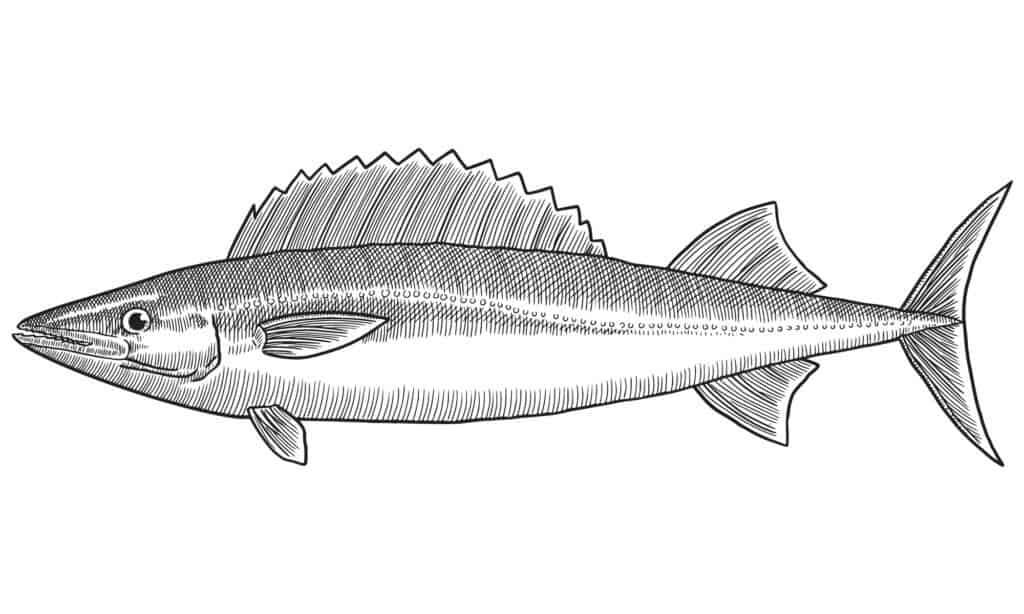
Escolar is a type of snake mackerel.
©Intellegent Design/Shutterstock.com
Distribution, Population, and Habitat
The escolar is found in the mesopelagic and epipelagic zones of warmer seas. The mesopelagic zone is also called the ocean’s twilight zone and is found between 660 to 3300 feet below the surface. The epipelagic zone is the top layer of the ocean and receives sunlight.
The fish is known for staying in the mesopelagic zone during the day and then rising to the epipelagic zone at night. It is often part of a tuna by-catch and is most often found near ridges, underwater cliffs, and ledges. It seems especially abundant around Japan, Korea, the United States, and Italy.
Predators and Prey
The escolar’s prey includes other fish such as mackerel, tuna, bonito, pomfrets, dolphinfish, and types of oarfish. They also eat squid and crustaceans. Though it can swim fast, biologists believe that this fish waits for its prey to pass within striking distance. It then grabs and eats it.
One fish that preys on the escolar is the yellowfin tuna which can weigh twice as much as the escolar. Humans, of course, are also predators of the escolar.
Reproduction and Lifespan
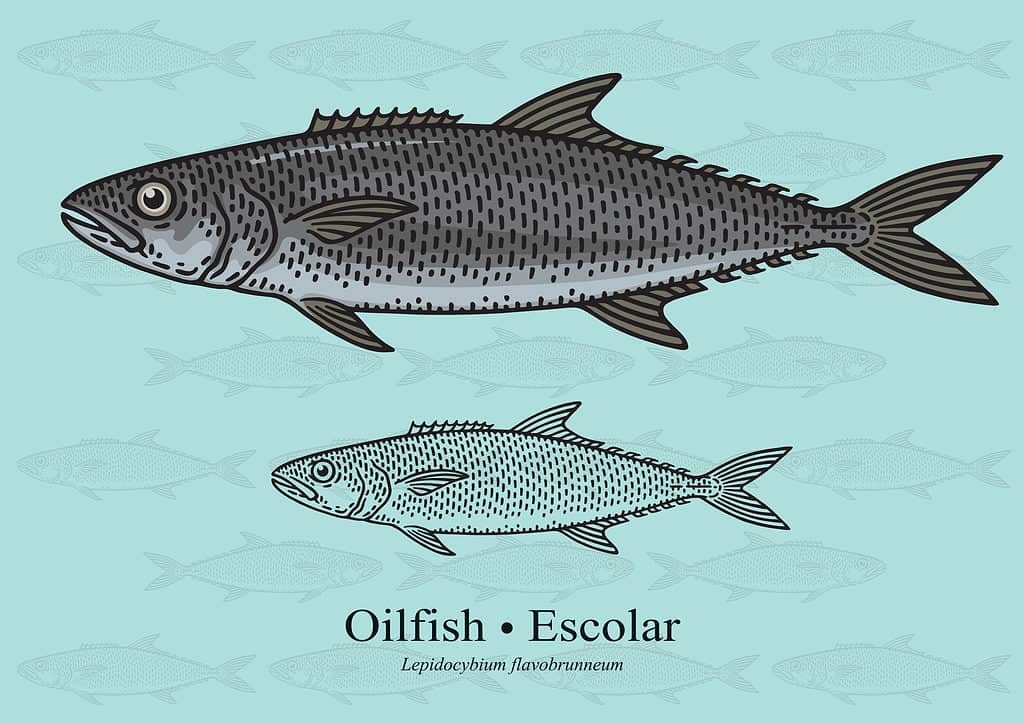
Eating oilfish meat can cause symptoms like severe diarrhea, nausea, and vomiting in some people.
©The Fisherman/Shutterstock.com
Not much is known about the escolar’s reproduction, but it’s believed that they probably spawn in May and/or November. It’s also probable that the fish migrates long distances to reach its spawning or feeding areas. Though escolar is solitary for most of its life, it can be found in numbers in these areas.
Scientists also know that the escolar is oviparous, which means it lays eggs. The female deposits as many as 300,000 eggs into the water, while the male deposits sperm. The eggs are then fertilized and become part of the plankton.
Biologists believe that escolars are ready to breed when they’re between 0.98 and 1.15 feet long. They appear to have a lifespan longer than 11 years.
Fishing and Cooking
Many people who have tasted escolar swear that it’s the best fish they’ve ever had, with a rich, silken texture that rivals that of the best quality tuna. Besides sushi rolls, nigiri sushi, and sashimi, it can be broiled, baked, grilled, poached, steamed, and sautéed.
The nutrition provided by the fish is admirable. Six ounces of escolar has 354 calories, 30 grams of protein, 23.4 grams of fat, and 175 milligrams of sodium.
Despite its great taste and the nutrition found in the meat, it needs to be eaten sparingly to avoid the discussed side effects. These side effects can kick in as early as half an hour after eating too much of this fish.
Population
The population of this fish isn’t precisely known, but its conservation status is least concern.
View all 117 animals that start with EEscolar FAQs (Frequently Asked Questions)
What is escolar?
An escolar is a fish that lives deep in the ocean that is known for the delicious taste of its meat and for the fact that the meat can give a person the trots.
What happens when you eat too much escolar?
If you eat too much of the flesh of this fish, you can get a case of diarrhea or an uncontrollable seepage of orange oil.
Why does escolar make you poop?
The reason is too much wax ester. The metabolisms of neither the escolar nor the human can handle this compound well. In the case of the fish, it simply stores the wax ester, but humans get a type of diarrhea called keriorrhea.
Can escolar be eaten raw?
Escolar can be eaten raw and is a fish used in sushi and sashimi dishes, including sushi rolls and nigiri sushi. In sushi rolls, vinegared rice is placed on a square of nori seaweed, slices of fish are placed on the rice, and the whole thing is rolled up using a bamboo mat. The resulting roll is sliced into bite-sized pieces. In nigiri sushi, a slice of fish is placed on a finger of vinegared rice.
How do you identify escolar?
The fish itself is a large, brown or black fish with keels on the root of its tail, a lower jaw that juts out past the upper jaw and large eyes. When it comes to buying it as food, it should be labeled as escolar. It is sometimes mistakenly labeled as white tuna or something else. It’s important to ask your fishmonger if the fish is indeed escolar.
What does escolar taste like?
Many people praise the fish’s silky, buttery, rich flavor. This makes them want to eat ore of it, but they really shouldn’t!
What are the key differences between a tuna and an escolar?
The key differences between a tuna and an escolar are appearance, health effects, and culinary uses.
Thank you for reading! Have some feedback for us? Contact the AZ Animals editorial team.
Sources
- , Available here: https://kidadl.com/animal-facts/escolar-facts
- , Available here: https://www.chefs-resources.com/seafood/finfish/escolar/
- , Available here: https://caseagrant.ucsd.edu/seafood-profiles/escolar
- , Available here: https://www.itis.gov/servlet/SingleRpt/SingleRpt?search_topic=TSN&search_value=172362#null
- , Available here: https://globalseafoods.com/blogs/news/escolar-it-is-no-accident
- , Available here: https://www.fishbase.se/summary/1042
- , Available here: https://en.wikipedia.org/wiki/Escolar









